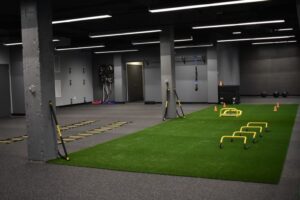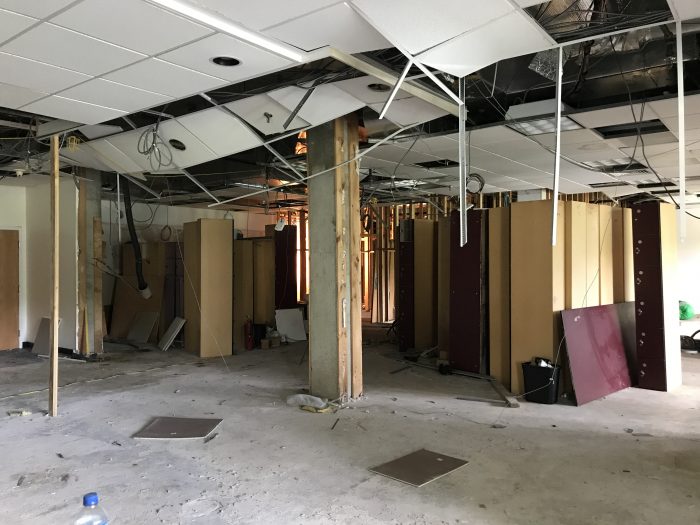You’ll need to answer some tough questions, visualize the type of business you want to set up, put time into a business plan, consider finances, and work hard to start your own gym.
Knowing where to start was the biggest challenge when opening my own training studio four years ago. It was one of the scariest, yet most exciting things I have ever done. I had the confidence in my coaching abilities and knew I had a quality product to offer, but from there navigating the landscape of starting my own training studio was overwhelming.
Here is how I’d approach it if I were to start all over.
1. Ask yourself a few questions before you start.
- This business will be 24/7 of your life from now until…it’s not. Are you ok with that?
- Are you ok waiting for 3 years or more to see a real return on investment?
- Are you willing to make sacrifices in your personal life, like not seeing your family that much or missing out on family vacations because you need to be at the gym?
- Are you good eating tuna fish sandwiches for breakfast, lunch, and dinner to make sure you can pay your team?
If you have any inclining of hesitation on these questions, let me be real with you, you’re probably not ready for ownership. If you are ready for this commitment, then here’s where I’d suggest you go next.
2. Ask yourself, what kind of business do I want to open up?

Thinking critically about this is key. There are many different ownership options for trainers these days, so it’s important to think about your strengths and weaknesses and about what makes you unique.
Don’t open a gym that’s focused on athletes if you’ve never trained an athlete a day in your life. However, if you’re the trainer who has become the local expert in Women’s Fitness, then find your opportunity there.
Maybe it’s a women’s only gym? Maybe it’s a Mommy & Me gym? Maybe the right business model is a partnership with another business who has the same target market, like a yoga studio and rent space from them.
3. Check yourself by writing a Business Plan.
Writing a business plan will force you to explore everything from the mission to marketing to money. This will make you look critically at your idea.
It’s not enough to have the idea. The idea has to make sense and you need to examine the idea forwards, backward, and in every direction. A Business Plan will do this for you.
4. Calculating start-up costs
You need to spend some money to make money. Especially if you don’t have a solid client base to help pay the bills right away. This can seem impossible but look at it as an investment. Where the money comes from is a different discussion.
Figure out how much money you will need to start a gym with these steps. It’s different for each business owner.
- Create a business plan and a financial plan
- Build up 3 months of reserves based upon monthly operating costs
- Calculate start-up costs
- Add 20% to the total of what you think you need
- Minimize equipment costs
How Much Money Do I Need to Start a Gym?
Accumulate at least 3 months of reserves, i.e. your monthly operating budget, before you begin your build-out. This means if your operating costs (rent, utilities, employees, etc.) are $20,000 a month, you need $60,000 in the bank.
Your startup costs should also account for the following:
- Build Out Costs – on average $150,000 – $300,000
- Legal – $3,000
- Insurance, license and permit fees – $2,000 – $3,000
- Equipment and supplies – 10% of total operating budget
- Advertising and promotion – 10% of total operating budget
- Employee expenses – expect this to be 25% to 50% of your operating budget
- Utilities – approx. $5.00 a square ft. on average
- Technical & office supply expenses – $5,000 – $10,000
- Inventory – depending on what you decided to do 10% – 20% of total budget
*based on the average. private training gym – not typical for traditional health clubs
Add 20% to the plan:
- If you’ve budgeted $200K in start-up costs, then plan to spend $240K
- If you think it will take you 6 mos. to get 50 members, plan it to 20% more time
Have someone else look at your plan. Find a good mentor, talk to your local SBA, offer to present your plan at a local networking event in exchange for feedback. Get as much feedback as you can.
Don’t ask your mom, dad or best friend to do this. You need critical, non-biased feedback. And expect feedback. Then go back to your plan and make the changes.
How Do I Raise Capital?
Treat your business like you would buying a house. If you can’t put at least 20% down on your own, you may not be ready. Forcing yourself to come up with the 20% on your own is a good test for whether or not you’re prepared to make this commitment.
There are traditional options like SBA loans and other small business loans. These can be hard to get unless you have good credit and business history.
Some people raise the capital with family help. Please, please don’t ask Dad to liquidate his 401K. He will likely offer, but do the right thing and SAY NO.
If you’re borrowing money from family, you should treat them as you would any investor/loan agency. Agree on a repayment plan and talk about a fair interest rate.
Angel Investors can be good options too, but just keep in mind these kinds of investors expect to get paid, even if you don’t make it. They also will likely expect an ownership stake. This means sharing your profits. While typically a silent partner, they will expect answers from you on business decisions, kind of like a boss would.
How Much Money Do I Spend On Equipment?
Open with want you need and then figure out what you want later. A good rule of thumb is to spend less than 10% of your annual operating costs for equipment purchases. This means that if your operating costs are $500K annual than you shouldn’t spend more than $50K on your initial equipment investment.
If you’re thinking about opening a traditional health club this looks different and you’re probably talking at minimum a $750K start-up investment on equipment alone.
I opened my training studio with virtually no equipment. Approximately $3,000 in assets. I didn’t make a significant investment in my equipment until year three.
Equipment should not be the reason your business is successful. Quality programming that delivers results is what will make you a success. A commitment to your members and community is what will make you successful. You can create the feel of a big gym even if you own a smaller studio.
The reality is – you really don’t know what you need until your business gets going.

Real life mistake: In one of my closets, I have this box of 25 mats. They’ve been sitting there for over a year now. I had one client complain about the hard floor and I panicked and went out and spent over $1,000 on mats…two weeks later I had turf put in, and the mats never got used.
This is needs vs. wants. I wanted to make one client happy. I didn’t need to. Had I thought it through, I would have waited for the flooring change to see if it was a still a problem.
How Much Money Can I Make Owning a Training Studio?
You can make as much as you’re willing to put in. The most powerful thing ever told to me, by my mentor, Thomas Plumber, when I started on my journey to ownership, was that 20% of gyms will never turn a profit, 60% will just break even and less than 20% will actually turn a profit.
While these statistics are scary, it’s reality. To be in the top 20% it takes everything you have and even then, the odds are long. However, if you are willing to have the courage and to not let the fear of failure stand in your way, then you can be successful.
How much you will make, then depends on you. Gyms that don’t have systems in place, that don’t understand the value of customer service, that don’t spend at least $3,000 a month on targeted advertising (i.e. social media) and who don’t focus on staff development, will not be successful.
Gyms that do these things well and are consistent with these must-dos, can find themselves in the top 20%, grossing over 1 million dollars annually. Remember though, to be top in the 20% you have to do the work.
You’ve got to spend time and money to earn money. Best of luck! Get in touch if you need support.
Starting a gym from scratch is an exciting adventure, so it comes with many risks. Planning properly and learning from those who have already been there will set you up for success.



